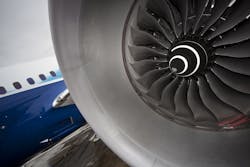Worldwide economic growth has made way for affordable travel and a high passenger demand, now and into the foreseeable future.
“We have experienced a period of substantive growth in the aviation industry, due to solid growth in Gross Domestic Product, low unemployment rates, low interest rates and moderate fuel prices,” explained Kari Williams, vice president marketing – Services, Rolls-Royce. “All of this has enabled more affordable travel, as airlines have been able to generate consecutive years of profitability and expand their operations through acquiring new modern aircraft and retaining older aircraft due to lower fuel prices.”
As a result, Williams notes the industry is experiencing a growing demand for MRO, due to the expanding global fleet and older aircraft coming in for an additional overhaul. “Today, a large proportion of MRO spend is for older aircraft but as we move forward, we will see new-generation aircraft accounting for the majority of MRO spend,” she pointed out.
“Today and looking out a few years, we see a very strong passenger demand, increasing load factors and strong worldwide economic growth,” said Joe Sylvestro, vice president of global aftermarket operations at Pratt & Whitney. “This tends to favour aircraft in service currently, which in turn means an increase in engine overhaul and maintenance. Overall, we see a long-term growth cycle for engine maintenance and we are positioned to be able to support customer demand accordingly.”
Keeping Up with Growth
Pratt & Whitney expects with close to 7,000 engines in service, the V2500 will be in high service demand for the next decade or more. The company anticipates the PW4000 and PW2000 engines to still be in service and continue be an important part of its overall engine portfolio.
For the GTF, the GTF MRO network currently has seven active engine centers: Pratt & Whitney Columbus Engine Center, Pratt & Whitney West Palm Beach, Pratt & Whitney Eagle Services Asia, MTU-Hannover, IHI-Mizuho, LHT Hamburg and LHT Alzey. By 2020, there will be nine active GTF MRO engine centers. Sylvestro says the goal of the network is to provide the highest quality maintenance support for GTF engine customers. As volume grows, the network is expected to expand to include other airline and MRO shops.
Rolls-Royce’s fleet size is expected to double in the next 10 years and triple in the next 20. The company’s business model is linked to providing CareServices across the whole product lifecycle and a key part of this is engine maintenance, repair and overhaul. This means Rolls-Royce is focused on providing the right size network at the right time and ensuring there isn’t significant overcapacity.
To deal with the growing MRO demand, Rolls-Royce will develop its services network through repurposing, expanding and partnering with overhaul bases to ensure its customers have access to the capable, competitive and flexible offerings that they require.
“We will accelerate growth to meet short-term requirements and handle surge capacity,” notes Williams. Rolls-Royce has recently repurposed its facilities in Canada and Germany, expanded its partnerships with Sanad Aerotech and StandardAero, and partnered with the likes of Delta TechOps and Air France/KLM Engineering & Maintenance to deliver the capacity required.
Similar But Different
The technological improvements and advancements used in new-generation jet engines allow the engine to run at higher temperatures, to achieve higher fuel efficiency and specific thrust. The core components are designed to withstand considerably more arduous conditions. What does this mean for the future of MRO of these engines?
“As new-generation jet engines reach maturity, we expect them to achieve similar interval times between maintenance as older engines, since life-limited parts will also be a factor that drives maintenance events,” explained Williams.
As new repair technologies continue to be developed and deployed for new materials and designs in the new-generation engines (e.g. greater composite materials, thermal coatings, blisks) the content of the work will differ, but the amount of work will be similar, she said. “Overhaul and component repair facilities will continue to adopt new technologies, developing novel methodologies and approaches,” she noted. “They will also drive cost efficiencies as the cost of maintenance will increase, due to the use of more expensive and advanced materials.”
Rolls-Royce is now able to extract more data from modern engines using its Engine Health Monitoring, which allows the company to reduce unplanned maintenance. With greater access to data, Rolls-Royce is able to treat each of the engines as an individual rather than assuming every engine is experiencing the worst-case conditions, helping extend the engine’s time on wing. The company is also using digital technology to develop and innovate new services such as Intelligent Lifing, which optimises inspection and maintenance intervals – which is part of CareServices.
At Pratt & Whitney, the GTF has been designed for easier maintenance, including fewer stages and parts, and borescope ports in every stage, allowing for more efficient line maintenance. In fact, “we have received more than 10,000 GTF engine orders and commitments, including options and spares,” explained Sylvestro. “We anticipate that shop visits for the GTF engine will continue to increase over the next few years and therefore, we are growing our GTF MRO network to support these customer commitments.”
Pratt & Whitney is helping customers ensure the right information is in place to service engines more quickly. “We understand that no two operators are the same and that they have different engines, aircraft, geographic routes, operational needs and environmental conditions,” stated Sylvestro. “Analytics technologies allow us to use global fleet data while monitoring the unique environments in which individual aircraft fly.”
New data acquisition and predictive analytics tools, such as the company’s eFAST data ecosystem and Advanced Diagnostics and Engine Management system, enable both operators and Pratt & Whitney to make recommendations that reduce operational disruptions and increase aircraft utilization.
What’s #Trending
“As the aviation market has been experiencing strong and robust growth and profitability, we are seeing that independent MRO providers and airline-affiliated MROs are expanding their business and capabilities,” noted Williams. “Some airlines are expanding their in-house capabilities as they see the high potential of the MRO market (for example: Delta, KLM E&M and Sanad Aerotech).”
Rolls-Royce has MRO presence in Singapore and Hong Kong. The company foresees further MRO expansion within China and Asia Pacific due to this high potential. Countries such as Thailand, Indonesia and Malaysia are increasingly investing in MRO facilities in order to replicate the success seen in Singapore and Hong Kong, Williams pointed out. “This is especially true for aircraft maintenance due to the lower starting capital required relative to engine overhaul,” she said.
A major trend is in automation and additive manufacturing. Pratt & Whitney has introduced a number of automation and digital tools on its manufacturing and assembly processes. These tools include robotics and automation, machine modeling, isothermal forging and inspection tools which enable the comapny to do things faster and reduce cost, while improving quality and on-time delivery. “As we continue to invest in automation and connectivity within our four walls and outside to our global supply base, we will continue to drive productivity,” Sylvestro said.
Pratt & Whitney has used additive manufacturing for decades with rapid prototyping of plastics to enhance manufacturing and speed production - from design, to prototyping, to finished product. “We recently announced our first application of additive manufacturing in MRO at one of our Singapore facility,” Sylvestro explained. “We fully expect the use of additive manufacturing to continue to grow. It is an important next step for companies to pursue and compete globally.”
With that, Pratt & Whitney currently has virtual, augmented, and mixed reality tools under development to support immersion training, providing a more effective customer training experience that can be accessed from remote locations.
By the Numbers
Despite 2019 seeing slowing economic and traffic growth compared to previous solid levels, Rolls-Royce says the past year has been a strong one for sales of both new products, aftermarket services and for aircraft transitions. “The growth of our CareNetwork enabled us to achieve 10 % more shop visits than the previous year,” Williams mentioned. “In 2019, we have expanded our UK MRO and repurposed Rolls-Royce Canada and Rolls-Royce Deutschland to deliver the capacity required for our customers.”
To support growth going forward, the company aims to bring new players into the network where it has zero equity and create the platform for the future of civil aerospace. “Airline MROs such as Delta TechOps and Air France/KLM, and independent MRO providers Sanad Aerotech and StandardAero are already a testament to the success of this strategy,” noted Williams.
The past year was strong for Pratt & Whitney in the aftermarket arena. Pratt & Whitney’s Eagle Services Asia inducted its first GTF engine early in 2019 and Delta Tech Ops joined the GTF MRO network. In addition, Pratt & Whitney continued to invest in support of GTF customers, with a $45 million investment to increase the capacity and capability of the West Palm Beach site to perform GTF engine disassembly, assembly and test operations. The network continues to grow to support growing customer demand and will include nine MRO shops by the end of 2020.
Pratt & Whitney has also grown its GTF engine repair network to include 10 suppliers. “These suppliers have had long-term relationships with Pratt & Whitney and deliver a high level of responsiveness, exactly what we are looking for to support our network for the GTF engine for years to come,” noted Sylvestro. “Along with that, we have seen continued interest in our EngineWise services, with 10 customers signing up for EngineWise Comprehensive service agreements across 2019.






